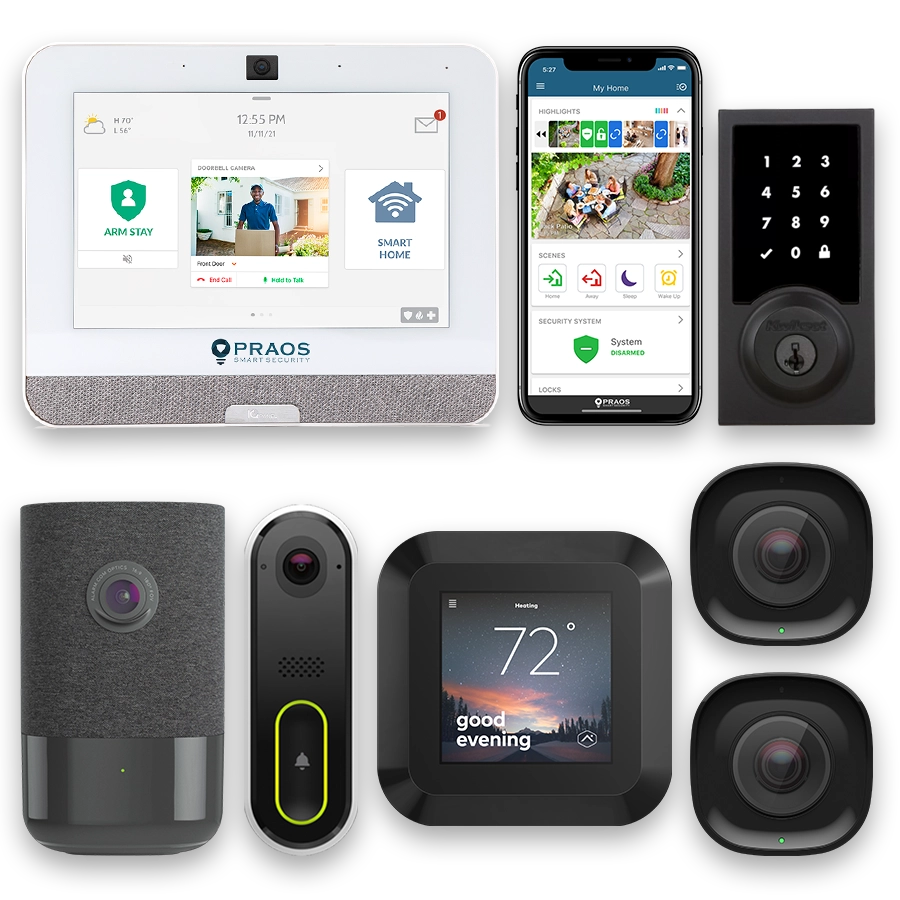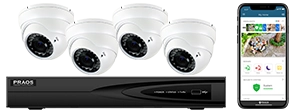Introduction to Home Automation
Home automation refers to the technology-driven process of automating various household functions and tasks. This can include lighting, heating, security systems, and even kitchen appliances, all of which can be controlled remotely or set to operate automatically based on predefined schedules.
The idea behind home automation is to enhance convenience, comfort, and energy efficiency while also improving home security. By integrating various smart devices and systems, homeowners can control and monitor their home environment more effectively.
One key aspect of home automation is the use of centralized control systems, which can be accessed through a smartphone, tablet, or dedicated control panel. This allows users to manage their home’s systems from virtually anywhere, providing flexibility and peace of mind.
In recent years, advancements in technology have made home automation more accessible and affordable for a wider audience. The proliferation of wireless communication protocols, such as Wi-Fi, Zigbee, and Z-Wave, has simplified the integration and installation of smart home devices.
With these advancements, home automation systems are now available in various forms and levels of complexity, ranging from simple, single-device solutions to comprehensive, whole-home systems that integrate multiple functions and devices.
Overall, home automation represents a significant step forward in enhancing the quality of life for homeowners, offering both practical and security benefits while also catering to the growing demand for smart, connected living environments.
The Evolution and History of Home Automation
Home automation has undergone significant evolution, marked by advancements in technology that have made it more accessible and useful. The concept of automating home functions dates back to the invention of simple devices like automatic door openers and basic thermostats. However, the scope and complexity of home automation have expanded dramatically over the years.
The journey began in the early 20th century with the invention of labor-saving electrical appliances such as washing machines and dishwashers. These were standalone devices that improved household efficiency but lacked integration and easy set up, which are hallmarks of modern home automation.
In the 1960s and 1970s, home automation began to incorporate more sophisticated technology. X10, a communication protocol for remote control of electrical devices, was developed in 1975. This protocol used the existing electrical wiring in homes to send signals between devices, enabling remote control of lighting and appliances. While revolutionary at the time, X10 had limitations, including issues with signal reliability and limited functionality.
As microprocessor technology advanced, the 1980s and 1990s saw the introduction of more complex home automation systems. Technologies like the European Installation Bus (EIB) and LonWorks emerged, enabling greater control and automation of home systems. Despite their capabilities, these systems were often expensive and complicated to install, limiting their adoption to high-end homes and commercial buildings.
The real transformation in home automation came with the advent of the internet and wireless communication technologies in the late 1990s and early 2000s. The introduction of Wi-Fi, along with advancements in sensors and microcontrollers, provided the foundation for more accessible, user-friendly, and scalable home automation solutions. The Internet of Things (IoT) further propelled this evolution, enabling devices to communicate seamlessly over the internet.
Today, home automation systems are characterized by integrated platforms that allow various smart devices to interoperate. Platforms like Apple’s HomeKit, Google’s Nest, and Amazon’s Alexa have popularized smart home ecosystems, making it easier for consumers to adopt and utilize automation technologies. Features like voice control, remote access via smartphones, and interoperability between different manufacturers’ devices have become commonplace.
Additionally, the development of robust wireless protocols such as Zigbee and Z-Wave has enhanced the reliability and functionality of home automation systems. These protocols prioritize low power consumption and mesh networking, making it easier to integrate multiple devices within a home.
Security in home automation has also evolved, with encryption and other cybersecurity measures becoming an integral part of modern systems. As smart homes become more connected, ensuring the security of data and devices has become a priority for manufacturers and users alike.
Overall, the history of home automation is a testament to technological progress, moving from simple mechanical solutions to highly sophisticated systems that offer convenience, efficiency, and enhanced security. The continuous evolution of technology promises further advancements, making smart homes increasingly capable and integral to everyday living.
Types of Home Automation Systems
Home automation systems can be broadly categorized into three main types: single-tasking systems, Multitasking systems, and integrated systems.
Single-tasking systems are designed to perform one specific function within a home. These systems are often simple and affordable, making them accessible to a wide range of users. Examples include smart lighting, which allows users to control lights remotely or set schedules, and smart locks, which enable keyless entry using a smartphone app.
Multitasking systems handle multiple functions within the home, often consolidating control into one device or application. These systems might include platforms that manage both lighting and climate control, providing users with a more versatile and cohesive setup. For instance, a single app might allow users to adjust their thermostat, control their lights, and monitor security cameras.
Integrated systems represent the most comprehensive type of home automation. These systems typically connect various devices throughout the home into a unified network, allowing for seamless interaction and control. Integrated systems often utilize advanced technology such as artificial intelligence and machine learning to provide smart, adaptive control over home environments. Examples include fully integrated smart home hubs like Amazon Echo or Google Home, which connect a multitude of devices from different manufacturers and allow them to work together cohesively.
When choosing a home automation system, factors to consider include compatibility with existing devices, the scalability of the system, and the user interface. Compatibility is crucial to ensure that current and future devices can be incorporated into the system. Scalability is important for users who may want to expand their system over time, adding new devices as their needs evolve. The user interface should be intuitive and easy to use, minimizing the learning curve and simplifying operation.
By understanding the different types of home automation systems, users can make informed decisions to suit their specific needs and preferences. Whether beginning with a single-tasking system or investing in a fully integrated setup, the variety of options available provides flexibility and choice for enhancing convenience and security in the home.
Key Technologies in Home Automation
4. Key Technologies in Home Automation
Advancements in home automation are deeply rooted in several key technologies that enable seamless integration, control, and monitoring of various home systems. Understanding these technologies provides insight into how they contribute to the convenience and security of smart homes.
4.1 Internet of Things (IoT)
The Internet of Things (IoT) is the backbone of home automation. IoT refers to the network of interconnected devices that communicate and share data with each other over the internet. These devices range from smart thermostats and lighting systems to security cameras and home appliances.
- Connectivity: IoT systems rely on Wi-Fi, Bluetooth, or Zigbee to connect devices throughout the home.
- Data Sharing: Devices share real-time data to provide homeowners with valuable insights and control capabilities.
4.2 Artificial Intelligence (AI)
Artificial Intelligence (AI) plays a pivotal role in optimizing home automation. AI algorithms analyze data from smart devices to learn user preferences and automate tasks accordingly. This creates a more personalized and efficient living environment.
- Machine Learning: AI systems constantly learn from user interactions to predict future needs and make intelligent decisions.
- Voice Assistants: AI-powered voice assistants like Amazon Alexa, Google Assistant, and Apple Siri enable hands-free control of various home appliances.
4.3 Wireless Communication Protocols
Reliable wireless communication is essential for the seamless operation of smart home devices. Several protocols ensure efficient communication within home automation systems:
| Protocol | Description |
|---|---|
| Wi-Fi | Widely used for high-speed data transfer and remote access to devices via the internet. |
| Bluetooth | Commonly used for short-range device communication and control, particularly for personal gadgets. |
| Zigbee | Low-power, low-data rate communication protocol, ideal for battery-operated devices like sensors. |
| Z-Wave | Designed for home automation, offers reliable communication with a mesh network topology. |
4.4 Cloud Computing
Cloud computing enhances home automation by providing robust storage, processing power, and remote accessibility. Data from smart devices is stored in the cloud, ensuring it is always accessible to authorized users. Cloud services also enable firmware updates and the integration of third party applications.
- Remote Management: Homeowners can control and monitor their homes from anywhere in the world using internet-connected devices.
- Data Security: Cloud providers invest in advanced security measures to protect user data from breaches and unauthorized access.
4.5 Sensors and Actuators
Sensors and actuators are critical components of home automation systems. Sensors detect changes in the environment, such as temperature, light, or motion. Actuators respond to these changes by initiating specific actions, like adjusting the thermostat or turning on lights.
- Types of Sensors:
- Temperature Sensors
- Motion Detectors
- Light Sensors
- Humidity Sensors
- Types of Actuators:
- Smart Thermostats
- Automated Lighting Systems
- Motorized Blinds
- Smart Locks
By leveraging these key technologies, home automation systems provide enhanced convenience and security, making everyday living more efficient and enjoyable.
Benefits of Home Automation: Convenience and Security
Home automation provides numerous benefits that can significantly enhance both the convenience and security of your living environment. The integration of smart home technologies can streamline daily routines and introduce advanced security measures, making life more comfortable and safer.
Convenience
One of the primary advantages of home automation is the convenience it offers. Smart home devices, such as voice-controlled speakers and automated thermostats, simplify everyday tasks. These devices can be controlled remotely through smartphone apps, allowing users to manage their home environment from virtually anywhere.
- Energy management: Smart thermostats learn your schedule and adjust the temperature accordingly, resulting in optimized energy consumption and potential cost savings.
- Lighting control: Automated lighting systems can be programmed to turn on or off at specific times, enhancing both comfort and energy efficiency.
- Appliance control: Devices such as smart plugs allow for the remote control of various household appliances, adding a layer of convenience to daily life.
In addition to remote control, many smart devices can automate tasks based on user preferences and routines. For example, lights can be set to turn on as you arrive home, and coffee makers can be programmed to start brewing when you wake up. The automation of such tasks can lead to a more streamlined and efficient daily routine.
Security
Home automation is not only about convenience but also significantly enhances household security. The integration of smart security systems can help protect property and ensure the safety of occupants.
- Surveillance: Smart cameras offer real-time video feeds and motion detection alerts, allowing homeowners to monitor their property remotely.
- Access control: Smart locks enable users to lock and unlock doors through mobile apps, and some models offer features like temporary access codes for guests or service personnel.
- Intrusion detection: Smart sensors can detect and alert you to unauthorized entry, and some systems can notify emergency services automatically.
Enhanced security features also include integration with third party monitoring services, which can provide around-the-clock surveillance and rapid response in case of emergencies. The likelihood of determent increases as potential intruders recognize the presence of advanced security systems.
Combining Convenience and Security
Many smart home systems offer combined benefits of convenience and security, addressing both aspects concurrently. For example, a smart doorbell not only provides video surveillance and intercom functionalities but also allows remote access control, thus enhancing both security and convenience.
| Feature | Description |
|---|---|
| Remote Monitoring | Provides real-time access to live and recorded footage from smart cameras. |
| Automated Alerts | Sends notifications for events such as motion detection or door access. |
| Energy Efficiency | Automates heating, cooling, and lighting to reduce energy consumption. |
Automating your home serves as a multifaceted solution that not only simplifies everyday living but also enhances the overall safety and efficiency of your household environment. As technology continues to advance, the scope and effectiveness of home automation systems are likely to expand, further enriching these benefits.
Popular Home Automation Devices and Solutions
Several popular home automation devices and solutions have significantly influenced how people manage their homes. These devices not only aim to enhance convenience but also improve security and energy efficiency.
1. Smart Speakers and Voice Assistants
Smart speakers, such as the Amazon Echo and Google Nest, are central to many home automation systems. These devices respond to voice commands and can control various other smart home devices. According to a report by Strategy Analytics, the global smart speaker market grew by 45% in 2020, highlighting their increasing popularity.
- Amazon Echo: Features the Alexa voice assistant, which can control lights, thermostats, and more.
- Google Nest: Uses Google Assistant to perform similar tasks and integrates seamlessly with other Google services.
2. Smart Lighting Systems
Smart lighting systems, like Philips Hue and LIFX, allow users to control lighting remotely, schedule operations, and adjust brightness or color. These systems increase convenience and can lead to energy savings. For example, according to Statista, the global market for smart lighting is projected to reach $21.6 billion by 2026.
- Philips Hue: Offers a wide range of customizable lighting solutions controlled via an app or voice commands.
- LIFX: Provides smart bulbs with various color options and integration with major smart home platforms.
3. Smart Thermostats
Smart thermostats, such as the Nest Learning Thermostat and Ecobee, help manage home heating and cooling more efficiently. These devices learn user preferences and adjust settings automatically to optimize energy use. Studies indicate that smart thermostats can reduce heating and cooling costs by 10-15%.
- Nest Learning Thermostat: Learns your schedule and programming preferences, compatible with most HVAC systems.
- Ecobee: Offers room sensors to monitor temperature and occupancy and make relevant adjustments.
4. Smart Security Systems
Home automation also extends to security through devices like smart cameras, locks, and alarms. Products such as the Arlo cameras and Ring Video Doorbells provide remote monitoring and alerts. According to MarketsandMarkets, the smart home security market is expected to grow from $2 billion in 2020 to $5 billion by 2025.
- Arlo Pro Cameras: Offer high-definition video, night vision, and cloud storage options.
- Ring Video Doorbells: Enable homeowners to see and speak with visitors remotely.
5. Smart Plugs and Switches
Smart plugs and switches, for example, those provided by TP-Link’s Kasa Smart and Wemo, allow for the remote control of appliances and lights. They integrate easily with most smart home ecosystems and offer features like scheduling and energy monitoring.
- Kasa Smart Plugs: Can be controlled via the Kasa app or voice assistants like Amazon Alexa and Google Assistant.
- Wemo Smart Switches: Offer similar functionalities with easy installation and integration.
Overall, the growing adoption and variety of home automation devices underscore their role in making life easier and more secure. As technology advances, the capabilities of these devices are likely to expand, offering even greater benefits.
Challenges and Concerns in Home Automation
Home automation offers numerous advantages, such as enhanced convenience, security, and energy efficiency. However, several challenges and concerns need addressing to ensure seamless adoption and usage.
1. Privacy Concerns: One of the primary challenges associated with home automation is privacy. As these systems collect and analyze data to function effectively, they may pose privacy risks. Unauthorized access to sensitive data, such as daily routines, personal preferences, and security codes, can compromise users’ privacy.
2. Security Risks: Home automation systems are susceptible to cyberattacks, which may result in unauthorized control over various devices. Cybercriminals can exploit vulnerabilities in these systems to gain access to security cameras, door locks, and other critical components. Ensuring robust encryption and regular security updates is essential to mitigate these risks.
3. Interoperability Issues: The integration of different devices and platforms can be challenging due to the lack of standardization. Proprietary protocols and incompatible systems may hinder seamless communication between devices, resulting in inefficiencies and limited functionality. Industry-wide standardization can address these interoperability issues.
4. Cost: The initial cost of home automation systems can be high, which may deter potential users. While basic systems are relatively affordable, installing comprehensive solutions that include advanced features can be prohibitively expensive for many households. Moreover, ongoing maintenance and potential repairs may add to the overall cost of ownership.
| Concern | Description |
|---|---|
| Privacy | Risks associated with data collection and unauthorized access to personal information. |
| Security | Potential for cyberattacks and unauthorized control of home automation devices. |
| Interoperability | Challenges in integrating devices from different manufacturers due to lack of standardization. |
| Cost | High initial installation costs and ongoing maintenance expenses. |
5. Reliability: Home automation systems depend heavily on stable internet connections and power supplies. Any disruption in these services can render the automation system non-functional. Ensuring backup power solutions and reliable internet service providers is crucial for maintaining system reliability.
6. User Experience: The complexity of some home automation systems may pose usability challenges for non-technical users. Intuitive interfaces and user-friendly designs are essential to enhance user experience and ensure that all household members can benefit from the technology effectively.
The Future of Home Automation
The future of home automation looks promising, driven by advancements in technology and increasing consumer demand for convenience, security, and energy efficiency. Emerging trends and innovations are expected to significantly shape the way homes are automated and managed.
Artificial Intelligence and Machine Learning
Artificial Intelligence (AI) and Machine Learning (ML) are poised to revolutionize home automation by enabling systems to learn from user behaviors and preferences. These technologies can enhance the efficiency and responsiveness of home automation systems by predicting user needs and automating routine tasks seamlessly.
For instance, AI-powered assistants like Amazon Alexa, Google Assistant, and Apple’s Siri are becoming smarter and more capable of controlling various smart home devices through voice commands.
Internet of Things (IoT) Integration
The integration of IoT devices is continually expanding, with more household items becoming ‘smart’ and connected. This allows for greater interoperability and coordination between different devices, creating a more cohesive and comprehensive home automation ecosystem.
Smart appliances, lighting systems, security cameras, and thermostats are just a few examples of IoT devices increasingly being used in home automation. According to Statista, the number of connected IoT devices globally is expected to grow to 75.44 billion by 2025.
Enhanced Security Features
As home automation systems become more sophisticated, there is a growing focus on security features to protect users’ data and privacy. Biometric authentication methods, such as facial recognition and fingerprint scanning, are being integrated into smart home security systems to provide stronger protection against unauthorized access.
Additionally, advancements in cybersecurity measures are crucial in mitigating risks associated with potential hacking and unauthorized control of smart home devices.
Energy Efficiency and Sustainability
Future home automation systems will prioritize energy efficiency and sustainability, with smart devices designed to optimize energy consumption. Smart thermostats, lighting, and energy monitoring systems can significantly reduce energy usage and costs by making real-time adjustments based on occupancy and environmental conditions.
According to the International Energy Agency, smart home technologies could save up to 230 million tonnes of CO2 emissions per year by 2030.
5G Connectivity
The rollout of 5G networks is expected to enhance the performance and responsiveness of home automation systems. With faster data transfer speeds and lower latency, 5G will enable instantaneous communication between devices, leading to smoother, more reliable home automation experiences.
Voice and Gesture Control
Advancements in natural language processing and gesture recognition technologies are making interaction with smart home devices more intuitive and user-friendly. Voice control, in particular, is becoming a standard feature in many home automation systems, providing hands-free convenience for users.
In conclusion, the future of home automation is characterized by significant technological advancements that promise to make homes smarter, more efficient, and more secure. As these trends continue to develop, they will increasingly enhance the quality of life for users by providing seamless and intelligent control over their living environments.






